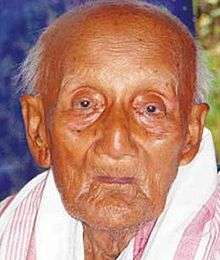Sonaram Sutiya
| Sonaram Sutiya | |
|---|---|
 | |
| Native name | সোণাৰাম চুতীয়া (Assamese) |
| Born |
8 June 1915 Bamkukurachowa village, Jorhat, British Raj (present-day Assam, India) |
| Died |
30 January 2013 (aged 98) Jorhat, Assam |
| Nationality | Indian |
| Other names | Vaishnav Pandit |
| Ethnicity | Assamese |
| Alma mater | Cotton College |
| Known for | Srimanta Sankardeva Sangha, Freedom fighter, Educationist |
| Religion | Hinduism, later Ekasarana Dharma |
| Children | Seven |
| Parent(s) |
Jagiram Sutiya (father) Phuleswari Sutiya (mother) |
| Awards |
Freedom fighter award-Union government (1972), Assam Government (1973) Srimanta Sankaradeva-Madhabdeva Award Srimanta Sankaradeva Award Jorhat Ekalabya and Dalit Daradi |
Sonaram Sutiya [1](also known as "Vaishnav Pandit") was a Vaishnav scholar, Freedom fighter and Educationist from Assam, India. Born in Bamkukurachowa village in the Jorhat district of Assam during the British Raj, Sutiya was educated in Jorhat and completed his B.Sc from Cotton College. Throughout his education, Sutiya witnessed insulting comments from upper-caste boys and instances of disrespectful mistreatment from religious establishments towards certain communities. It is said that these experiences prompted Sutiya to take up his cause against casteism.
Sutiya[2] began his career as a science teacher at the Sivasagar Government Higher Secondary School in 1939 but left his job and joined the Jatiya Mahasabha. He was jailed during the Quit India Movement, and he met Pitambar Dev Goswami, Satradhikar of the Garmurh Satra, in prison in 1943. In 1946, Sutiya joined the Srimanta Sankaradeva Sangha, devoting himself to working for the organisation for the rest of his life.
Sutiya[3] was honoured as a freedom fighter by the Union government in 1972 and the government of Assam in 1973. He received the Srimanta Sankardeva-Madhabdeva Award in 1994. In 2000, the Assam government bestowed the Srimanta Sankaradeva Award on him. In 2005, he was awarded as Jorhat Ekalabya and Dalit Daradi by North Eastern Research Organization. A Gandhian in life, Sutiya was a student of Class X, when he saw Gandhiji for the first time and met him personally later in Maharashtra.
Early Life
Sonaram Sutiya was born into an ethnic Assamese Sutiya family on 8 June 1915 to Jagiram Sutiya and Phuleswari Sutiya in Jorhat district of Assam. Sutiya started his schooling in Bamkukurachowa L.P. school in 1922. In 1935, he passed his Matriculation with distinction. He scored letter marks in General Mathematics, Sanskrit, Assamese, Advanced Mathematics and Mechanics. That year, young Sutiya was the only student to score letter marks in the Matriculation. He completed a B.Sc with distinction at the prestigious Cotton College in 1939. Due to the Second World War, he left his studies and started working as a science teacher in Sivasagar Government Higher Secondary School in 1939.
Struggle for Indian Independence
In 1940 he left his job and joined the Jatiya Mahasabha (Indian National Congress), an organisation working towards India's Independence. In 1942 he played an active role in Quit India movement. As a freedom fighter, he was arrested by the British in the same year and sent to Jorhat Central Jail. Before being sent to jail, he was working as a teacher in Teok Balama high school and Kakojan high school.
In jail, he met veteran Assamese freedom fighters Gopinath Bordoloi, Fakhruddin Ali Ahmed, Debeswar Sarma, and Pitambar Dev Goswami. After 2 years and 18 days in Jorhat Central jail, Sutiya was released on 22 December 1944. Following his release, he was placed under house arrest for 6 months. In 1945, he began teaching again at Teok Balama High School.
Vaishnav Scholar
In 1946 he joined Palakhani Ashram of Nagaon, which was run by Ramakanta Muktiyaron, on the birth anniversary of Srimanta Sankardev. In 1958 he joined as Rural Development Officer in Golaghat district and for the first time in 1956, he was selected as president of 28th Srimanta Sankardev Sangha Adhibekhon, Saraidoloni, Lakhimpur. Till 1978 he was selected as the president of Srimanta Sankardev Sangha for 9 times in various places of Assam. In 1978 he was selected the president of 47th Srimanta Sankardev Sangha Adhibekhon, Guwahati, Assam. From 1978 onwards, he acted as the chief advisor of Srimanta Sankardev Sangha and was a member of Saran team. On 10 April 1975, he retired from Teok Rajabari High School as a Headmaster. After that he fully devoted his life to Srimanta Sankardev Sangha.
Literary works
He began writing 1939 after he joined the Dharma Mahasabha. His books were highly influenced by Sankari Culture and Mahapusia Dharma. Most of them were related to Vishnuism in Assam. Until his death, he wrote various books and articles in many different Assamese magazines. In 1954, he published his first book "Naam Dharma Prakash".
Books wrote by Sonaram Sutiya:
- Naam Dharma Prakash (1954 )
- Mahapurush Haridev Charit (1968 )
- Axomor Vaisnav DarshanorSwarnarekha (1971 )
- Bikhudgarror Bichitra Kahani ( 1976 )
- Mundan ( 1978 )
- Bhagawat Mahatyama ( 1984 )
- Mahapusia Dharma Jigyassa ( 1986 )
- Ved aaru Mahapusia Dharma ( 1988 )
- Axomor Satra : Ek Anuhandhan ( 2003 )
- Aami Bhagawanor Dakh (2003)
- Vakti Ratnawali
- Huvor Okhodhi
- Ishwaror Sabbyabyapita
- Mahapusia Dharma aru Karmakando